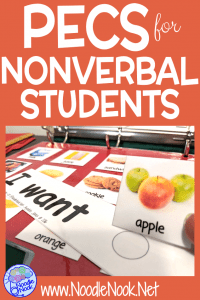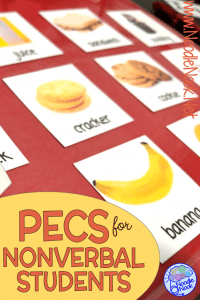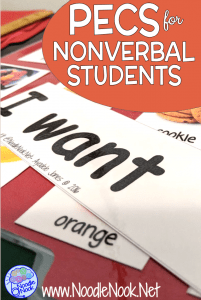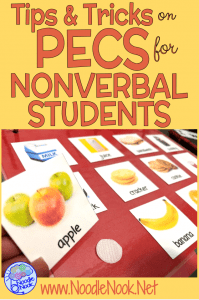Picture Exchange for nonverbal students is an effective way to implement a communication system. PECS™ is a picture exchange communication system that anyone can use. It relies on three main principles and a cycle of phases. With a little bit of effort on your part, you can implement a meaningful way to communicate for the nonverbal students in your classroom.

Three Principles of Picture Exchange
If you are working with a student who has a communication delay or is nonverbal, there are some things you’ll want to consider before you start with picture exchange.
FIRST STEP
The first thing to consider is if a student is trying to communicate with you. This can be by pulling you to things, gesturing and pointing, with echolalic speech, or with other grunts and vocalizations. This signals you that is student is capable of communication and is ready for a system that will make their communication more effective. Now is the time too… as a student who wants to communicate experiences more misinterpretation and fails to get their wants and needs met the result will be more issues with attention seeking behavior or tantrums.
Take action now because your students wants to communicate with you and they need a way to do so effectively.
SECOND STEP
The second thing to determine is a student’s favorites and needs. Motivation is a huge part of picture exchange. Let’s face it. If I love hot wheels and you keep making me exchange a picture of broccoli for a green snack, we aren’t gonna get far. The student you are targeting for picture exchange will need to learn the picture system has power. It has the power to get them what they want. In order to establish that effectively and get that student buy in, you’ll want to start with exchanging icons that are highly desired. Learn about the student’s favorite things and needs by doing a basic motivational assessment or asking parents what preferred items a student gravitates towards.
THIRD STEP
The third thing in the picture exchange process is to implement the 6 phases of picture exchange with fidelity. As you are working with nonverbal student to implement picture exchange, it may seem like it is all on the student… but that is far from the truth. The success or failure of the student’s system is all on you as the teacher and your support staff. You have to go through all the phases of picture exchange and be consistent with it. You have to use the system as much as possible whenever possible and always with the same model of delivery (even if there are multiple adults training the system).
The most heartbreaking thing I’ve seen recently is a teacher who worked with a student for 3 years on a communication system with mind blowing successes (astonishing increases in communication and drastic decreases in injurious behavior) only to send him off to middle school and his new teacher decide it was too much work. All forward momentum stopped. And it was because of the adults, not the student. So, please… be consistent and get you fellow staff members to buy in too.
The 6 Phases of Picture Exchange
I hope you are a believer now. I hope you see what a student needs to be successful, what information you need to make things work, and how you as the adult are driving your student’s success. Now onto the easy part, the six phases.
Step 1: Show a Picture- Get a Thing
Be consistent and swift with the item so students make a connection between the request and the reinforcer.
Step 2: Distance the Communication Partner
Instead of being right there with the instant gratification, there is more distance which works to delay getting the item.
Step 3: Discriminate Between Pictures
In order to add more pictures, a student has to be able to discriminate. I love to start discrimination with the target preferred item and a non-preferred item. Two preferred may not be effective since exchanging any picture would get a student something they like.
Step 4: Build it with a Sentence Stem
Now we want to build in some more language and the best stem to start with is the stem “I want”. It supports step five.
Step 5: Ask “What Do You Want?”
You will now build some partner communication skills and turn taking by adding a prompt like this one.
Step 6: Generalize to Other Stems
So a student can now comment and socially communicate, add stems like “it is” and “I see” so you can prompt with different asks and continue building the function of a student’s communication.

My Personal Success
It was late April. LATE.. and a new student transferred to my school. He was homeschooled abroad for the last 5 years and was starting as a 16 year old freshman since he had no credit. When I tell you his transfer shut our program down, we were immediately in a tailspin. My aides and I had already had already run the gauntlet that school year managing behaviors like fecal eating and smearing, self-injurious head banging and a student who came out of resource to self contained and was not happy about it (and he told us in a myriad of 4-letter words and elopmenent). So we had been tested already that year. When Jon, not his real name, moved in it made all those other things seem like the open book pretest. He was the final exam. We were being tested. TESTED!
After an eternity of urinating in the classroom, violent physical aggression, and terrible tantrums, my team and I were just counting down the days until summer. Heck, we counted the hours until the weekend, the minutes until the end of the day and the seconds until PE where he became someone else’s problem. Yeah… it was that bad. We had used all the behavior tools we could think of. We used a visual schedule, first-then charts, token economies, core boards and all the reinforcers we could lay our hands on. The rest of the students in the class were not learning anything because we were all in survival mode.
Then one day he laughed as I fanned my hot face (after a restraint and room evacuation). I turned and fanned his. He laughed again. A-HA! I had him!
After the students were all happily on the bus, I took a picture of that fan and printed it out in color, laminated it, and put it on the outside of an empty 3-ring binder. Tomorrow he was gonna tell me what he wanted.
I’d like to tell you it was a miracle. It wasn’t It was a marathon where the track is on fire and there’s no water. He understood the picture exchange right away. That first day he gave me the icon and I fanned him for just 3 seconds. Then I stopped. He would give me the icon again and he did this happily for half a day. Then the fan lost its charm. It was totally over. I panicked… I had to find something else and fast. My aide tried her little desk fan. It worked for a little while too, but nothing seemed to hold his attention very long.
Seems like a loss, right? But it wasn’t
He was an extreme case and needed a LOT of attention, but in one day we had him doing picture exchange and understanding the concept. In one day. One. Day. He was a smart kid and he was in there, had an opinion, and wanted to be heard. The problem was actually us, as the adults. We were only offering him one thing to say. Imagine if the only word you could say was ‘FAN’…. how long would that meet your needs? Once we started using targeted words in every content area and building complexity quicker, he used it more with more discrimination and consistency. We stuck him at phase 1 because he couldn’t talk, but he was at phase 3 and ready for phase 4 his first week in the exchange system. Once we picked it up to catch up to his communication ability, it did get better. We made it to the end of the year and Jon was one of out all time success stories. He moved away over the summer and we never saw him again, but I know we improved his quality of life for the couple months he was with us. He is also the one that made me believe in the ability of any student, no matter how challenging they present.
You are SUPER Important
I feel like I am beating a drum a top my soapbox again, but I hope you see the one driving force as you use picture exchange for nonverbal students and it is the adults. You are super important. Your team is super important. Success will depend on you all and your consistency, flexibility, and drive. You can do this… I promise. Now, stay strong and Picture exchange on!





